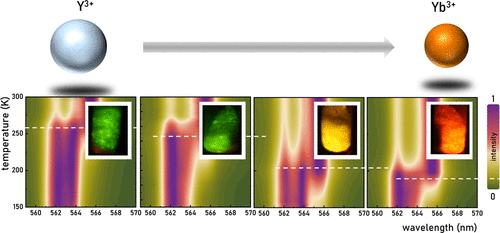当前位置:
X-MOL 学术
›
ACS Appl. Mater. Interfaces
›
论文详情
Our official English website, www.x-mol.net, welcomes your
feedback! (Note: you will need to create a separate account there.)
The Butterfly Effect: Multifaceted Consequences of Sensitizer Concentration Change in Phase Transition-based Luminescent Thermometer of LiYO2:Er3+,Yb3+
ACS Applied Materials & Interfaces ( IF 8.3 ) Pub Date : 2024-05-13 , DOI: 10.1021/acsami.4c03856 L Marciniak 1 , W Piotrowski 1 , M Szymczak 1 , C D S Brites 2 , V Kinzhybalo 1 , Hao Suo 3 , L D Carlos 2 , Feng Wang 3
ACS Applied Materials & Interfaces ( IF 8.3 ) Pub Date : 2024-05-13 , DOI: 10.1021/acsami.4c03856 L Marciniak 1 , W Piotrowski 1 , M Szymczak 1 , C D S Brites 2 , V Kinzhybalo 1 , Hao Suo 3 , L D Carlos 2 , Feng Wang 3
Affiliation

|
In response to the ongoing quest for new, highly sensitive upconverting luminescent thermometers, this article introduces, for the first time, upconverting luminescent thermometers based on thermally induced structured phase transitions. As demonstrated, the transition from the low-temperature monoclinic to the high-temperature tetragonal structures of LiYO2:Yb3+,Er3+ induces multifaceted modification in the spectroscopic properties of the examined material, influencing the spectral positions of luminescence bands, energy gap values between thermally coupled energy levels, and the red-to-green emission intensities ratio. Moreover, as illustrated, both the color of the emitted light and the phase transition temperature (from 265 K, for LiYO2:Er3+, 1%Yb3+, to 180 K, for 10%Yb3+), and consequently, the thermometric parameters of the luminescent thermometer can be modulated by the concentration of Yb3+ sensitizer ions. Establishing a correlation between the phase transition temperature and the mismatch of ion radii between the host material and dopant ions allows for smooth adjustment of the thermometric performance of such a thermometer following specific application requirements. Three different thermometric approaches were investigated using thermally coupled levels (SR = 1.8%/K at 180 K for 1%Yb3+), green to red emission intensities ratio (SR = 1.5%/K at 305 K for 2%Yb3+), and single band ratiometric approach (SR = 2.5%/K at 240 K for 10%Yb3+). The thermally induced structural phase transition in LiYO2:Er3+,Yb3+ has enabled the development of multiple upconverting luminescent thermometers. This innovative approach opens avenues for advancing the field of luminescence thermometry, offering enhanced relative thermal sensitivity and adaptability for various applications.
中文翻译:

蝴蝶效应:LiYO2:Er3+,Yb3+ 相变发光温度计中敏化剂浓度变化的多方面后果
为了响应对新型高灵敏度上变频发光温度计的持续探索,本文首次介绍了基于热致结构化相变的上变频发光温度计。正如所证明的,LiYO 2 :Yb 3+ ,Er 3+从低温单斜结构到高温四方结构的转变引起了所检测材料的光谱特性的多方面改变,影响了发光带的光谱位置、能量热耦合能级之间的间隙值以及红绿发射强度比。此外,如图所示,发射光的颜色和相变温度(从LiYO 2 :Er 3+ 、1%Yb 3+的265K到10%Yb 3+ 的180K),并且因此,发光温度计的测温参数可以通过Yb 3+敏化剂离子的浓度来调节。建立相变温度与基质材料和掺杂剂离子之间的离子半径失配之间的相关性,可以根据特定的应用要求平滑地调整此类温度计的测温性能。使用热耦合水平(1%Yb 3+在 180 K 时S R = 1.8%/K)、绿光与红光发射强度比(2% Yb 在 305 K 时S R = 1.5%/K)研究了三种不同的测温方法3+ ),以及单带比率法(10%Yb 3+在 240 K 时S R = 2.5%/K)。 LiYO 2 :Er 3+ ,Yb 3+中的热致结构相变使得多种上转换发光温度计的开发成为可能。这种创新方法为推进发光测温领域开辟了道路,提供增强的相对热灵敏度和对各种应用的适应性。
更新日期:2024-05-13
中文翻译:

蝴蝶效应:LiYO2:Er3+,Yb3+ 相变发光温度计中敏化剂浓度变化的多方面后果
为了响应对新型高灵敏度上变频发光温度计的持续探索,本文首次介绍了基于热致结构化相变的上变频发光温度计。正如所证明的,LiYO 2 :Yb 3+ ,Er 3+从低温单斜结构到高温四方结构的转变引起了所检测材料的光谱特性的多方面改变,影响了发光带的光谱位置、能量热耦合能级之间的间隙值以及红绿发射强度比。此外,如图所示,发射光的颜色和相变温度(从LiYO 2 :Er 3+ 、1%Yb 3+的265K到10%Yb 3+ 的180K),并且因此,发光温度计的测温参数可以通过Yb 3+敏化剂离子的浓度来调节。建立相变温度与基质材料和掺杂剂离子之间的离子半径失配之间的相关性,可以根据特定的应用要求平滑地调整此类温度计的测温性能。使用热耦合水平(1%Yb 3+在 180 K 时S R = 1.8%/K)、绿光与红光发射强度比(2% Yb 在 305 K 时S R = 1.5%/K)研究了三种不同的测温方法3+ ),以及单带比率法(10%Yb 3+在 240 K 时S R = 2.5%/K)。 LiYO 2 :Er 3+ ,Yb 3+中的热致结构相变使得多种上转换发光温度计的开发成为可能。这种创新方法为推进发光测温领域开辟了道路,提供增强的相对热灵敏度和对各种应用的适应性。


















































 京公网安备 11010802027423号
京公网安备 11010802027423号